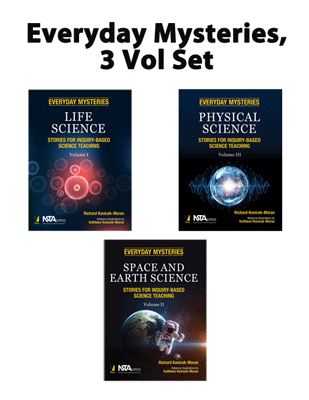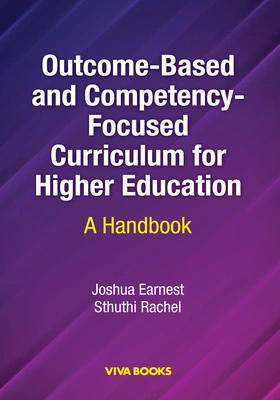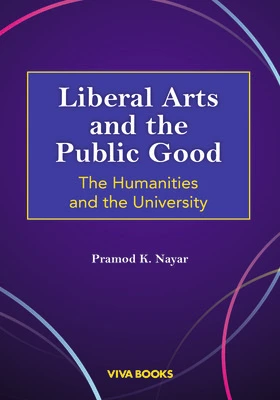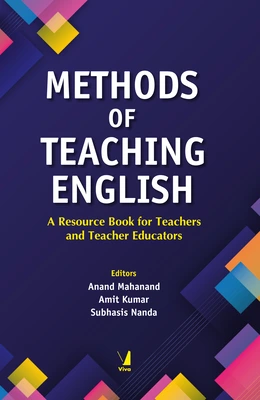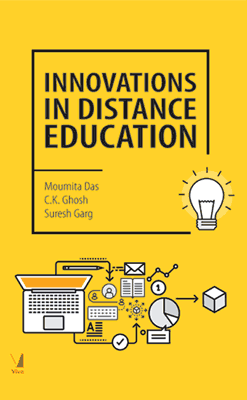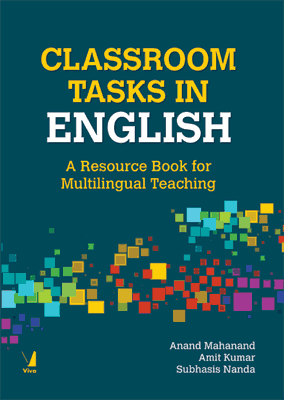Everyday Mysteries, 3 Volume Set
Everyday Mysteries, 3 Volume Set
Stories for Inquiry Based Science Teaching
₹2,245.50 ₹2,495.00 Save: ₹249.50 (10%)
Go to cartISBN: 9789386105929
Bind: Paperback
Year: 2017
Pages: 900
Size: 216 x 292 mm
Publisher: National Science Teachers Association
Published in India by: Viva Books
Exclusive Distributors: Viva Books
Sales Territory: India, Nepal, Pakistan, Bangladesh, Sri Lanka
Review:
"What makes this book so special is the unique way science is integrated into the storyline, using characters and situations children can easily identify with.?"
—Page Keeley, author of Uncovering Student Ideas in Science
Volume I: Life Sciences
Description:
How do tiny bugs get into oatmeal? What makes children look like-or different from-their parents? Where do rotten apples go after they fall off the tree? By presenting everyday mysteries like these, this book will motivate your students to carry out hands-on science investigations and actually care about the results. These 20 open-ended mysteries focus exclusively on biological science, including botany, human physiology, zoology, and health. The stories come with lists of science concepts to explore, grade-appropriate strategies for using them, and explanations of how the lessons align with national standards. They also relieve you of the tiring work of designing inquiry lessons from scratch.
Contents:
Acknowledgments • Preface: Teaching and Interpreting Science • Introduction: Case Studies on How to Use the Stories in the Classroom
Chapter 1: Theory Behind the Book
Chapter 2: Using the Book and the Stories
Chapter 3: Using this Book in Different Ways
Chapter 4: Science and Literacy
The Stories and Background Materials for Teachers
Chapter 5: Trees From Helicopters (Botany: tree flowers)
Chapter 6: Trees From Helicopters, Continued (Botany)
Chapter 7: Flowers: More Than Just Pretty (Botany)
Chapter 8: Looking at Lichens (Botany: symbiosis)
Chapter 9: Seedlings in a Jar (Botany: plant physiology)
Chapter 10: Seed Bargains (Botany: needs of seeds)
Chapter 11: Springtime in the Greenhouse (Botany: needs of seeds)
Chapter 12: Dried Apples (Botany: water for life)
Chapter 13: Plunk, Plunk (Botany: imbibition, water)
Chapter 14: Hitchhikers (Botany: how seeds travel)
Chapter 15: Halloween Science (Pumpkin science)
Chapter 16: In a Heartbeat (Human physiology: circulation)
Chapter 17: The Trouble With Bubble Gum (Health, nutrition)
Chapter 18: About Me (Human physiology: genetics and inheritance)
Chapter 19: A Tasteful Story (Human biology: taste, bad science)
Chapter 20: Reaction Time (Human physiology: human reaction tests)
Chapter 21: Worms Are for More Than Bait (Zoology: value of worms)
Chapter 22: What Did That Owl Eat? (Zoology: exploring owl pellets)
Chapter 23: Baking Bread (Life science: yeast and leavening)
Chapter 24: Oatmeal Bugs (Entomology: life cycles of insects)
Index
Volume II: Space and Earth Sciences
Description:
What are odds that a meteor will hit your house? Do you actually get more sunlight from Daylight Saving TiIme? Where do puddles go? By presenting everyday mysteries like these, this book will motivate your students to carry out hands-on science investigations and actually care about the results. There 19 open-ended mysteries focus exclusively on Earth and space Science, including astronomy, energy, climate and The stories come with lists of science concepts to explore, grade-appropriate strategies for using them, and explanations of how the lessons align with national standards. They also relieve you of the tiring work of designing inquiry lessons from scratch.
Contents:
Acknowledgments • Preface • Introduction: Case Studies on How to Use the Stories in the Classroom
Chapter 1: Theory Behind the Book
Chapter 2: Using the Book and the Stories
Chapter 3: Using the Book in Different Ways
Chapter 4: Science and Literacy
The Stories and Background Materials for Teachers
Chapter 5: Moon Tricks (Astronomy: looking for Moon patterns and finding reasons for phases)
Chapter 6: What's the Moon Like Around the World? (Astronomy: the Moon as seen from all parts of the world)
Chapter 7: Daylight Saving Time (Astronomy: time and how it is measured)
Chapter 8: Sunrise, Sunset (Astronomy: how do the sunrise and sunset directions change over the year?)
Chapter 9: Now Just Wait a Minute! (Time: making a device to tell time)
Chapter 10: What's Hiding in the Woodpile? (Energy: transfer of heat from wood to room air)
Chapter 11: Cool It, Dude! (Energy: cooling things off)
Chapter 12: The New Greenhouse (Energy: looking at the greenhouse effect)
Chapter 13: Where Did the Puddles Go? (Evaporation)
Chapter 14: The Little Tent That Cried (Evaporation-condensation cycle)
Chapter 15: Where Are the Acorns? (Astronomy: patterns in the daytime sky)
Chapter 16: The Coldest Time (Climate: finding the coldest time of the day)
Chapter 17: Frosty Morning (Microclimates around the school building)
Chapter 18: Master Gardener (Geology: rebuilding soil, erosion, weathering)
Chapter 19: A Day on Bare Mountain (Geology: rock cycle and diastrophism)
Chapter 20: What Are the Chances? (Geography: probability)
Chapter 21: Here's the Crusher (Atmosphere: air pressure)
Chapter 22: Rotten Apples (Decay on the Earth and recycling)
Chapter 23: Is the Earth Getting Heavier? (Decay and decomposition, recycling)
Index
Volume III: Physical Sciences
Description:
What can make a ball roll faster? Does the temperature of wood affect the heat of a fire? How can old-fashioned tin can telephones teach today's students about sound and technology? By presenting everyday mysteries like these, this book will motivate your students to carry out hands-on science investigations and actually care about the results. The 2 1 open-ended mysteries focus exclusively on physical science, including motion, friction, temperature, forces, and sound. The stories come with lists of science concepts to explore, grade-appropriate strategies for using them, and explanations of how the lessons align with national standards. They also relieve you of the tiring work of designing inquiry lessons from scratch.
Contents:
Acknowledgments • Preface: Teaching and Interpreting Science • Introduction: Case Studies on How to Use the Stories in the Classroom
Chapter 1: Theory Behind the Book
Chapter 2: Using the Book and the Stories
Chapter 3: Using This Book in Different Ways
Chapter 4: Science and Literacy
The Stories and Background Materials for Teachers
Chapter 5: Grandfather's Clock (Physics: periodic motion and experimental design)
Chapter 6: The Crooked Swing (Physics: engineering application of pendulums, improving a product)
Chapter 7: The Magic Balloon (Physics: gas and temperature laws)
Chapter 8: Bocce, Anyone? (Physics: moving bodies and ramps)
Chapter 9: Cooling Off (Physics: mixing different temperature liquids)
Chapter 10: Warm Clothes (Physics: temperature vs. heat)
Chapter 11: Party Meltdown (Physics: heat transfer: conduction)
Chapter 12: How Cold Is Cold? (Physics: thermodynamics with ice)
Chapter 13: Dancing Popcorn (Physics: density and buoyancy)
Chapter 14: Color Thieves (Physics: light, vision, color)
Chapter 15: A Mirror Big Enough (Physics: vision, reflection, mirrors)
Chapter 16: Stuck! (Physics: static and dynamic friction)
Chapter 17: St. Bernard Puppy (Physics: pressure, weight, mass)
Chapter 18: Iced Tea (Chemistry: dissolving, solutions and temperature)
Chapter 19: Pasta in a Hurry (Chemistry: effect of salt on boiling temperature)
Chapter 20: The Magnet Derby (Physics: testing magnet strength)
Chapter 21: The Cookie Dilemma (Chemistry: testing for chemicals)
Chapter 22: Sweet Talk (Chemistry: differences between melting and dissolving)
Chapter 23: The Slippery Glass (Weather: condensation and humidity)
Chapter 24: Florida Cars (Chemistry: rusting and chemical reactions)
Chapter 25: The Neighborhood Telephone System (Physics and engineering: sound and improving a product)
Index
Target Audience:
Helpful for Academicians and Teachers.
